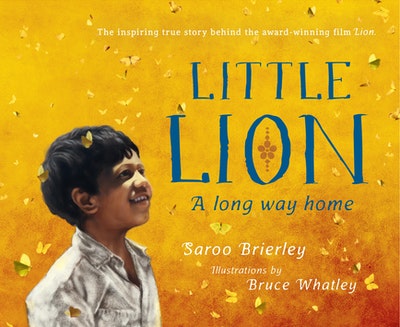‘Little Lion: a Long Way Home’ is a true story of survival. The story begins when a five-year-old boy, Saroo Brierley, born in Khandwa, Madhya Pradesh, India is separated from his older brother at a train station in India. Many train stops later, Saroo disembarks. He does not know the name of his family or his hometown, yet he survives for weeks on the streets of Calcutta (Kolkata). Fortunately, he is taken into an orphanage then adopted by an Australian family in Hobart, Tasmania.
Over the next 25 years, Saroo never forgot his family in India nor does he give up hope of a reunion one day. That reunion in 2012 made headlines around the world. His full story is recounted in his autobiography, ‘A Long Way Home,’ young readers’ edition ‘Lion: A Long Way Home’ and the picture book, described here. The film ‘Lion,’ based on his autobiography, captivated the world in November 2016. It was nominated for four Golden Globe and six Academy Awards.
Bruce Whatley used Photoshop to create the captivating illustrations that feature large-scale, darkly coloured, realistic details of Saroo’s daily life. Whatley researched the India setting and a young Saroo. The text is longer than most picture books, but the story is mesmerising. It recounts, from Saroo’s perspective, his time lost in an unfamiliar world, without family and little hope for the future. Fortunately, young Saroo is guided to a police station then taken to an orphanage where he is adopted by an Australian couple living in Hobart, Tasmania.
Saroo never gave up hope of reuniting with his family in India. While studying at University in Canberra, he discovered he could trace railways lines using Google Earth. After many trials, he recognised a familiar water tower and even his childhood home—memories as a five-year-old. He found his town Khandwa on the map and travelled to India to hopefully reunite with his family. In early 2012, after 25 years of separation, he finds his mother and other family members.
‘Little Lion’ is a suspenseful memoir, an unfamiliar form of writing that may interest young people. Bruce Whatley’s photo-realistic style perfectly reflects both time and place and captures the emotional moments of this true story.

